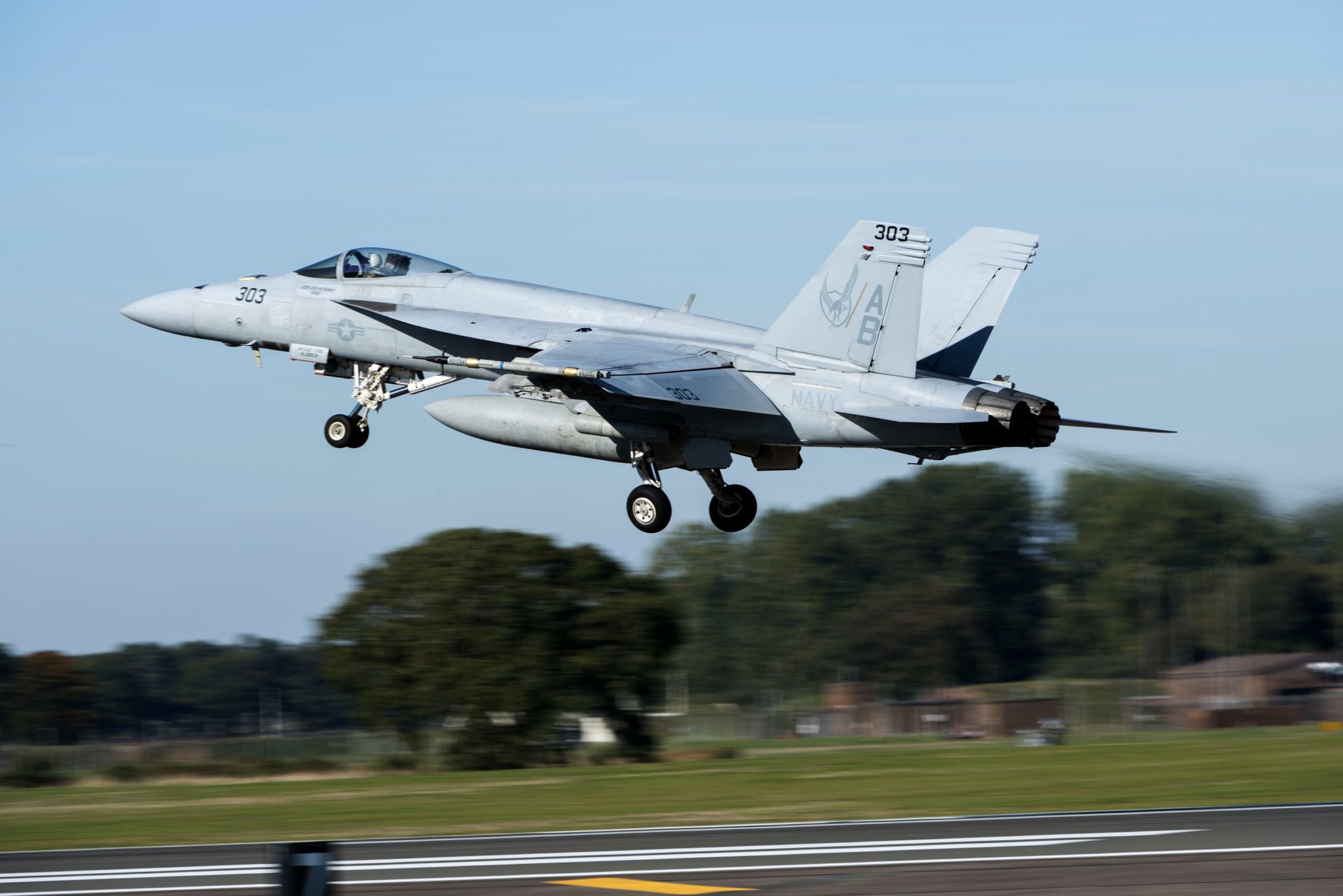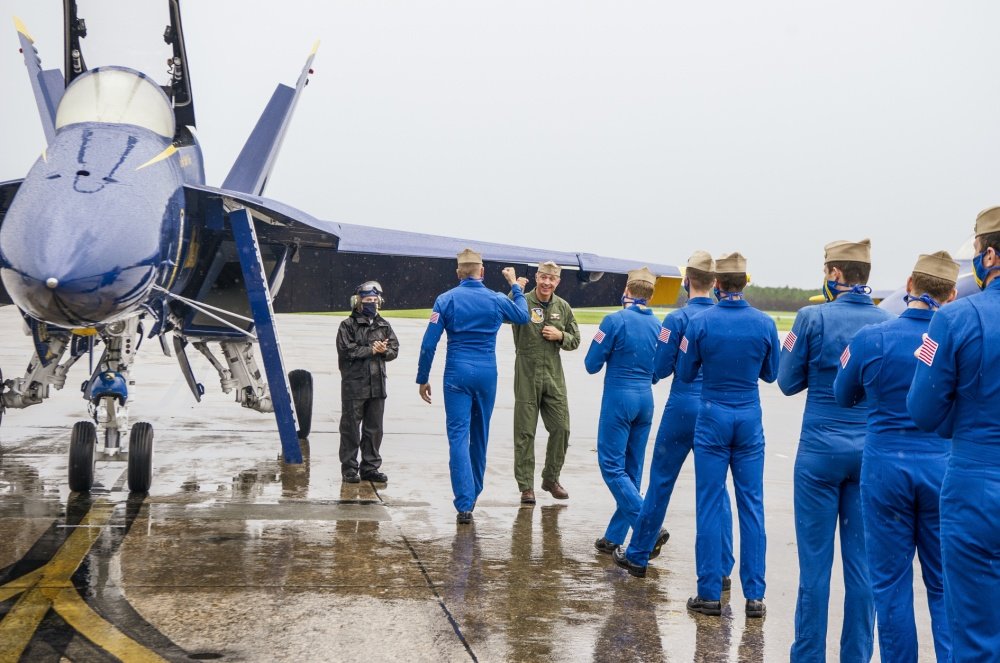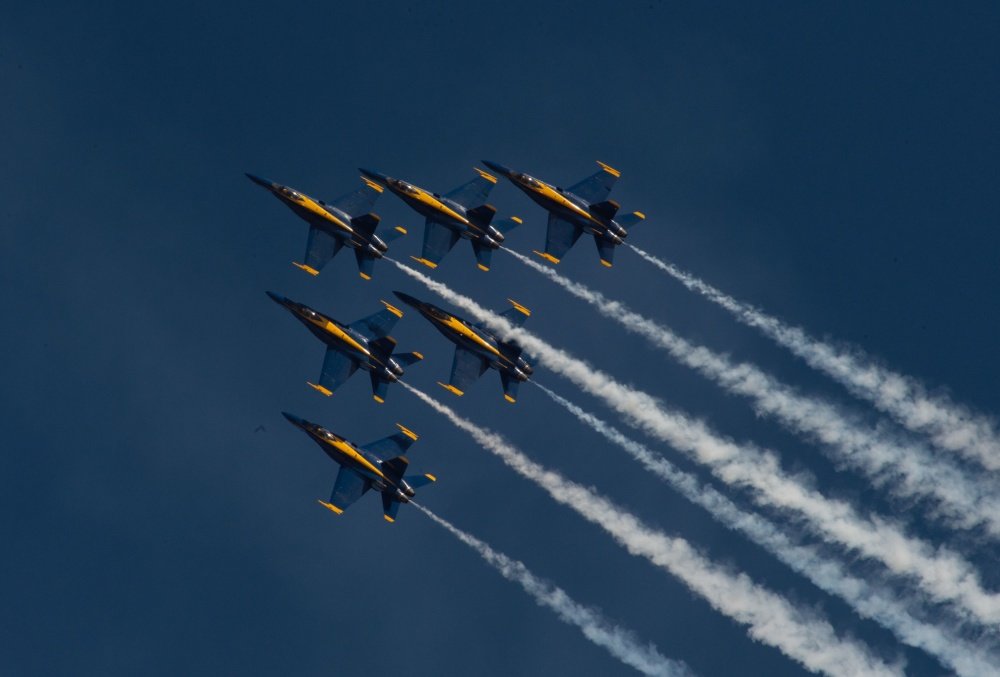
An F/A-18E Super Hornet assigned to the “Red Rippers” of Strike Fighter Squadron (VFA-11), deployed from the Nimitz-class aircraft carrier USS Harry S. Truman (CVN 75) launches for a sortie Oct. 9, 2018, at Royal Air Force Lakenheath, England. The carrier is currently operating in the U.S. 6th Fleet area of operations, fostering cooperation with regional allies and partners, strengthening regional stability, and remaining vigilant, agile and dynamic. (U.S. Air Force photo/Senior Airman Malcolm Mayfield)
After 34 years flying the F/A-18 Hornet jet fighter, the Blue Angels just got a new ride.
On Monday the U.S. Navy’s revered flight demonstration team received their first of 18 planned F/A-18 E/F Super Hornet jet fighters, part of a process to replace an aging fleet of so-called legacy Hornets.
Captain Eric Doyle, director of the Blue Angels Super Hornet Transition Team and a former Blue Angels commanding officer, flew the team’s first Super Hornet, bedecked in the Blue Angels’ signature blue and gold paint scheme, from Cecil Field in Jacksonville, Florida, to Naval Air Station Pensacola on Monday.
“We would like to especially thank the teams at Boeing, Chief of Naval Air Training Command, Naval Air Systems Command, Fleet Readiness Center Southeast, and Naval Supply Systems Command Weapons Systems Support,” said Commander Brian Kesselring, commanding officer and flight leader of the Blue Angels, in a statement. “The success of this mission was a direct reflection of their hard work.”
[ig_post url=”https://www.instagram.com/p/CDJ3JLgAq9f/?utm_source=ig_web_copy_link” /]
The Blue Angels are set to receive their full allotment of 18 Super Hornets by the end of this year and will be ready for shows in the new aircraft by 2021. The Super Hornets bound for the team are known as low-rate initial production (LRIP) airframes, meaning they’re among the oldest of that type of aircraft in the Navy’s inventory. Typically, such aircraft are used for flight tests or training, not combat.
The original F/A-18 Hornet multirole fighter was developed in the 1970s and was introduced into the U.S. Marine Corps and the Navy in the early 1980s. The Blue Angels adopted the fighter in 1986. Since its introduction, the Hornet became the staple workhouse warplane for the Navy and Marine Corps, playing a key role in conflicts from the 1991 Gulf War to the post-9/11 wars in Iraq and Afghanistan.
The current Hornet fleet used by the Blue Angels — comprising roughly 11 aircraft at any given time — have been modified for airshow duty by removing their cannons and adding smoke-oil tanks that mist the aircrafts’ jet exhaust. Additionally, a weighted spring affixed to the control sticks allows for more precision formation flying than fleet-version Hornets. The Blue Angels’ aircraft are, in theory, supposed to be capable of returning to the fleet for combat duty within 72 hours.

The Navy officially retired the F/A-18 C Hornet from combat service in 2019, paving the way for more advanced Super Hornet upgrades as well as integration of the F-35C Lightning II.
The Blue Angels shifted from the F/A-18 A/B model to the improved C/D model in 2010. However, that change was essentially between equivalent aircraft, whereas the Super Hornet upgrade means effectively transitioning to an entirely new airframe.
Originally developed by McDonnell Douglas (which is now a part of Boeing) the Super Hornet first flew in 1995 and was introduced to naval battle groups in 2001. Known among naval aviators as the “Rhino,” the Super Hornet is a more advanced aircraft than its predecessor — it’s also about 25% bigger, roughly 7,000 pounds heavier, and carries roughly a third more fuel as well as more weapons. The Super Hornet, which has an open source top speed of about Mach 1.6, also features upgrades to reduce its radar signature. The Blue Angels, incidentally, never fly supersonic during airshows.
One easy way to distinguish a Super Hornet is the angular shape of its engine inlets, as opposed to the more rounded design of those on legacy Hornets.

The Super Hornet has more thrust available than older Hornets, meaning it can make tighter turns and accelerate faster. However, one area in which the older Hornets have an advantage is in inverted flight. The Super Hornet is only authorized for 40 seconds of continuous inverted flight, while its predecessor is approved for 60 seconds.
The Super Hornets have been upgraded to new “blocks” over the years, integrating new technologies to improve weapons systems, performance, and survivability in combat. There are roughly 600 Super Hornets and their electronic warfare variant known as the Growler currently in service.
One thing that won’t change for Blue Angels aviators when they transition to the Super Hornet is the center-mounted control stick — meaning they won’t likely be adopting G-suits as they transition to their new aircraft fleet.
Unlike the U.S. Air Force Thunderbirds, which fly F-16 fighters equipped with side-mounted control sticks, F/A-18 Hornets and Super Hornets both feature control sticks positioned between the aviator’s knees. When flying, therefore, Blue Angels aviators typically rest their forearms on their laps. And for that reason they don’t wear G-suits like their Air Force Thunderbirds brethren, since the inflation of the specialized pant legs during high-g maneuvers — which is meant to squeeze a pilot’s legs and force blood to stay in the brain to prevent blackouts — could interfere with the sensitive control stick movements needed for close formation flying.

It costs about $2.7 million to convert each Super Hornet to a Blue Angels aircraft, on top of some $41 million to develop and procure the “kits” necessary to make such conversions possible. Altogether, that amounts to a price tag of roughly $90 million to swap out the Blue Angels’ current fleet for Super Hornets. Two of the Super Hornets destined for the Blue Angels were reportedly used in the filming of “Top Gun 2.”
The Blue Angels also recently added a C-130J transport aircraft, formerly belonging to the Royal Air Force, to its fleet as a support aircraft colloquially referred to as “Fat Albert.” The C-130J is an updated version of the C-130 transport place, which has been in service since the Vietnam era.
Prior to the adoption of the Hornet in 1986, the Blue Angels had flown the A-4F Skyhawk II since 1974, and the F-4J Phantom II fighter from 1969 to 1974. The Blue Angels began flying in 1946 with the F6F Hellcat, a carrier-based fighter that saw widespread service in the Pacific Theater of World War II.

BRCC and Bad Moon Print Press team up for an exclusive, limited-edition T-shirt design!
BRCC partners with Team Room Design for an exclusive T-shirt release!
Thirty Seconds Out has partnered with BRCC for an exclusive shirt design invoking the God of Winter.
Lucas O'Hara of Grizzly Forge has teamed up with BRCC for a badass, exclusive Shirt Club T-shirt design featuring his most popular knife and tiomahawk.
Coffee or Die sits down with one of the graphic designers behind Black Rifle Coffee's signature look and vibe.
Biden will award the Medal of Honor to a Vietnam War Army helicopter pilot who risked his life to save a reconnaissance team from almost certain death.
Ever wonder how much Jack Mandaville would f*ck sh*t up if he went back in time? The American Revolution didn't even see him coming.
A nearly 200-year-old West Point time capsule that at first appeared to yield little more than dust contains hidden treasure, the US Military Academy said.












